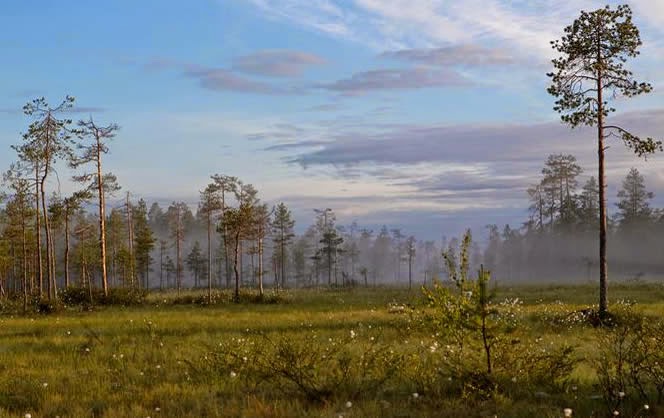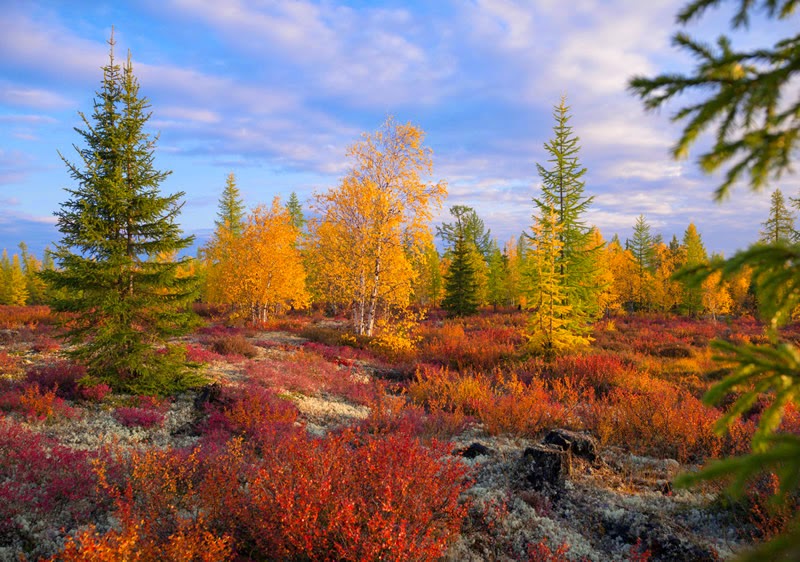 |
| Taiga in Findland |
“Taiga” derives from a Russian word for the forests of cone-bearing, needle-leaved, generally evergreen trees of northern Eurasia and North America. “Coniferous forest” and “boreal forest” are other names given to this biome.
Some botanists include the temperate rain forests along the Pacific Coast of North America and the coniferous forests in the western mountains in the taiga.
While the term “coniferous forest” can be applied to temperate rain forest and coniferous forest biomes in the western mountains, the terms “taiga” and “boreal forest” should be restricted to the northern forests. “Taiga” is also sometimes used in a more restricted way, to mean a subdivision of the boreal forest.
  |
Components
The dominant plants in the taiga are conebearing, needle-leaved, evergreen trees, such as pines, spruces, and firs. North American taiga is dominated by two species of spruce: black spruce (Picea mariana) and white spruce (Picea glauca). Jack pine (Pinus banksiana), balsam fir (Abies balsamea), and eastern larch (Larix laricina, a deciduous conifer) are also important in parts of the taiga.
A few deciduous flowering trees are also important components. Quaking aspen (Populus tremuloides, the most widespread tree species in North America) and paper birch (Betula papyrifera) are two examples. Eurasian taiga is dominated by related species of spruce and pine and has the same character.
Determinants and Adaptations
Taiga occurs in a broad band across Canada, Alaska, Siberia, and Europe; essentially, this band is interrupted only by oceans. This pattern suggests that climate plays a major role in determining the distribution of the taiga.
Average temperatures are cool, and precipitation is intermediate, but evaporation is low because of the cool temperatures. Hence, moisture is generally available to plants during the growing season. The growing season is short, and winters are long.
 |
| The dominant plants in the taiga are conebearing, needle-leaved, evergreen trees, such as pines, spruces, and firs. |
Permafrost is present in the northern part of the taiga, and wetlands are common because drainage is often deficient. These physical conditions are primarily determined by the high latitude at which taiga occurs, but why taiga develops under these conditions is not entirely clear.
The length of the growing season may help explain why the dominant taiga trees are evergreen. Because they retain their leaves through the winter, these trees can carry out some photosynthesis on mild winter days. More important, they avoid the energetic expense of replacing all their leaves at one time.
Deciduous trees put tremendous amounts of energy into leaf replacement each spring and must replace those energy stores as well as produce energy for growth during the growing season. Deciduous forests generally occur south of the taiga, where the growing season is longer. However, some deciduous trees are successful in the taiga, so other adaptations must also be important.
Asexual reproduction probably contributes to the success of taiga trees, especially in severe environments. Black and white spruce reproduce by layering, the growth of a new tree from a lower branch which makes contact with the ground.
   |
Most deciduous trees of the taiga can sprout from the roots or other underground parts if the above ground part of the tree is damaged or killed. Both strategies allow new trees to develop using the re sources of the parent tree. In contrast, some plant growing from seed do not have sufficient resource to survive.
Fire is an important environmental factor in the taiga. Many of the conifers produce at least some cones which open and release their seeds only after they have been heated intensely, as in a forest fire Jack pine responds to fire this way, as does black spruce to a lesser extent.
Most deciduous trees send up new stems from undamaged underground part after a taiga fire. White spruce does not employ either of these strategies but does have efficient seed dispersal and so can move into a burned area fairly quickly.
Similar adaptations make Eurasian taiga species fit for life in northern environments. Apparently, no single suite of adaptations suits a tree species for taiga life; instead various combinations of characteristics are employed by the different species.
Adjacent Zones
 |
| Adjacent Zones |
The taiga is bordered by tundra to the north, and the meeting place between the two biomes is a broad transition zone often called the “taiga-tundra,” or forest-tundra. This ecotone is composed of a mixture of forest and tundra plants, with trees becoming fewer and smaller from south to north until conditions become so harsh that trees can no longer grow.
The southern boundary of the taiga is often adjacent to deciduous forest, grassland, or parkland. These are also broad, transitional ecotones.
In eastern North America, the northern hardwood forest region is such a transition zone and is composed primarily of a mixture of trees from the deciduous forests and the taiga. The aspen parklands in the west are also transitional. Quaking aspen from the taiga and grasses from western grasslands mix in this zone between the taiga and grassland biomes.
Environmental Concerns
Human activities may have less impact on the taiga than on many other biomes, primarily because the taiga occurs in a harsh environment less accessible to humans than many other biomes. Still, there are serious concerns. Acid rain became a problem for the taiga in eastern Canada in the late twentieth century.
These forests are northeast of the industrial centers in the United States, and the prevailing south westerly winds move nitrogen and sulfur oxides into eastern Canada, where they precipitate on plants and soil. Both oxides interact with water to produce acids, thus acidifying the soil and plant leaves. Many ecologists believe that acid precipitation has seriously damaged the taiga.
America and Eurasia.
Global warming is a second and perhaps more insidious threat to the taiga. The taiga will almost certainly be negatively impacted by changes in temperature, the length of the growing season, fire frequency and intensity, and precipitation patterns.
Taiga itself may play a role in carbon storage and mitigation of the greenhouse effect. This possibility, its role as a source of timber, and the inherent value of the biome and its component species make it imperative that the taiga be conserved.